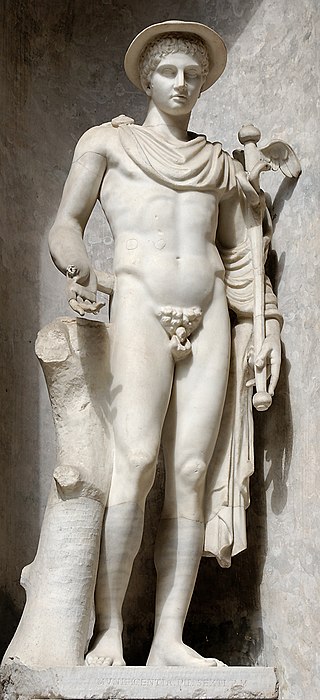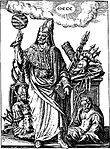
Apuleius was a Numidian Latin-language prose writer, Platonist philosopher and rhetorician. He was born in the Roman province of Numidia, in the Berber city of Madauros, modern-day M'Daourouch, Algeria. He studied Platonism in Athens, travelled to Italy, Asia Minor, and Egypt, and was an initiate in several cults or mysteries. The most famous incident in his life was when he was accused of using magic to gain the attentions of a wealthy widow. He declaimed and then distributed his own defense before the proconsul and a court of magistrates convened in Sabratha, near Oea. This is known as the Apologia.

Hermes is an Olympian deity in ancient Greek religion and mythology considered the herald of the gods. He is also considered the protector of human heralds, travelers, thieves, merchants, and orators. He is able to move quickly and freely between the worlds of the mortal and the divine aided by his winged sandals. Hermes plays the role of the psychopomp or "soul guide"—a conductor of souls into the afterlife.

Hermes Trismegistus is a legendary Hellenistic period figure that originated as a syncretic combination of the Greek god Hermes and the Egyptian god Thoth. He is the purported author of the Hermetica, a widely diverse series of ancient and medieval pseudepigraphica that lay the basis of various philosophical systems known as Hermeticism.

The caduceus is the staff carried by Hermes in Greek mythology and consequently by Hermes Trismegistus in Greco-Egyptian mythology. The same staff was borne by other heralds like Iris, the messenger of Hera. The short staff is entwined by two serpents, sometimes surmounted by wings. In Roman iconography, it was depicted being carried in the left hand of Mercury, the messenger of the gods.

Hermeticism or Hermetism is a philosophical and religious system based on the purported teachings of Hermes Trismegistus. These teachings are contained in the various writings attributed to Hermes, which were produced over a period spanning many centuries and may be very different in content and scope.

The Hermetica are texts attributed to the legendary Hellenistic figure Hermes Trismegistus, a syncretic combination of the Greek god Hermes and the Egyptian god Thoth. These texts may vary widely in content and purpose, but are usually subdivided into two main categories, the "technical" and "religio-philosophical" Hermetica.

The Corpus Hermeticum is a collection of 17 Greek writings whose authorship is traditionally attributed to the legendary Hellenistic figure Hermes Trismegistus, a syncretic combination of the Greek god Hermes and the Egyptian god Thoth. The treatises were originally written between c. 100 and c. 300 CE, but the collection as known today was first compiled by medieval Byzantine editors. It was translated into Latin in the 15th century by the Italian humanist scholars Marsilio Ficino (1433–1499) and Lodovico Lazzarelli (1447–1500).
Adam of Saint Victor was a prolific poet and composer of Latin hymns and sequences. He has been called "...the most illustrious exponent of the revival of liturgical poetry which the twelfth century affords."

The Emerald Tablet, also known as the Smaragdine Tablet or the Tabula Smaragdina, is a compact and cryptic Hermetic text. It was highly regarded by Islamic and European alchemists as the foundation of their art. Though attributed to the legendary Hellenistic figure Hermes Trismegistus, the text of the Emerald Tablet first appears in a number of early medieval Arabic sources, the oldest of which dates to the late eighth or early ninth century. It was translated into Latin several times in the twelfth and thirteenth centuries. Numerous interpretations and commentaries followed.

Poimandres is the first tractate in the Corpus Hermeticum.

Anselm of Lucca, born Anselm of Baggio, was a medieval bishop of Lucca in Italy and a prominent figure in the Investiture Controversy amid the fighting in central Italy between Matilda, countess of Tuscany, and Emperor Henry IV. His uncle Anselm preceded him as bishop of Lucca before being elected to the papacy as Pope Alexander II and so he is sometimes distinguished as Anselm the Younger or Anselm II.

Bibliotheca Philosophica Hermetica (BPH) or The Ritman Library is a Dutch library founded by Joost Ritman located in the Huis met de Hoofden at Keizersgracht 123, in the center of Amsterdam. The Bibliotheca Philosophica Hermetica brings together manuscripts and printed works in the field of Hermeticism, more specifically the 'Christian-Hermetic' tradition.

Ludovico Lazzarelli was an Italian poet, philosopher, courtier, hermeticist and (likely) magician and diviner of the early Renaissance.

The Definitions of Hermes Trismegistus to Asclepius is a collection of aphorisms attributed to the legendary Hellenistic figure Hermes Trismegistus, most likely dating to the first century CE.

The Cyranides is a compilation of magico-medical works in Greek first put together in the 4th century. Latin and Arabic translations also exists. It has been described as a "farrago" and a texte vivant, owing to the complexities of its transmission: it has been abridged, rearranged, and supplemented. The resulting compilation covers the magical properties and practical uses of gemstones, plants, and animals, and is a virtual encyclopedia of amulets; it also contains material pertinent to the history of western alchemy, and to New Testament studies, particularly in illuminating meanings of words and magico-religious practices. As a medical text, the Cyranides was held in relatively low esteem even in antiquity and the Middle Ages because of its use of vernacular language and reliance on lore rather than Hippocratic or Galenic medical theory.
Hermeticism in poetry, or hermetic poetry, is a form of obscure and difficult poetry, as of the Symbolist school, wherein the language and imagery are subjective, and where the suggestive power of the sound of words is as important as their meaning. The name alludes to the mythical Hermes Trismegistus.

The Discourse on the Eighth and Ninth is an ancient Hermetic treatise. It is one of the three short texts attributed to the legendary Hellenistic figure Hermes Trismegistus that were discovered among the Nag Hammadi findings.

Rémi Gounelle is a French protestant theologian, a professor of history of early Christianity at the Faculté de théologie protestante de Strasbourg and dean of that same faculty since 2010.
Kephalaia are a genre of Manichaean literature represented mainly by two large papyrus codices containing Coptic translations from 5th-century Roman Egypt. The kephalaia are sometimes seen as the actual words or teachings of the prophet Mani, but are probably better viewed as later discourses and interpretations laid upon "an authoritative oral tradition" ostensibly going back to Mani and thus analogous to the Talmud in Judaism and the ḥadīth in Islam.

The Prayer of Thanksgiving is a Hermetic Gnostic prayer text preserved in Coptic, Greek and Latin.









